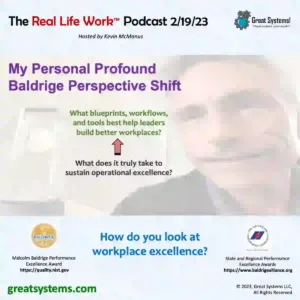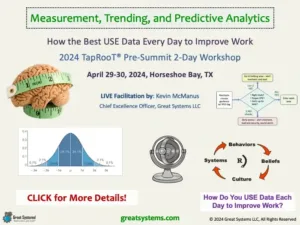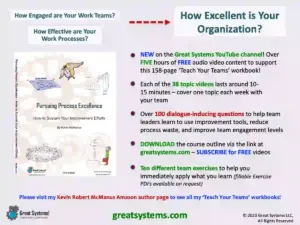How can you use the Baldrige award criteria to measure kaizen and operational excellence? Multiple options and benchmarks exist.
Use the Baldrige Award Criteria to Measure Operational Excellence
How Do You Measure Operational Excellence?
At the most basic level, it should be relatively easy to measure operational excellence. All you have to do is measure and look at the results!
Many would argue that all one needs to do is review a set of key performance indicators for all of the organization’s key performance areas. Is this not enough information for such an evaluation? When one uses the Baldrige award criteria to help measure operational excellence, they find that they need more than just excellent results.
Unfortunately, there are limitations if we only use ‘the numbers’ to assess performance excellence. This is especially true if one considers the future sustainability and competitiveness of the organization.
How effectively will current work system designs support the organization’s strategic intent over the next five to ten years? Are systematic processes in place to drive further work system design changes? How will we meet shifts in internal and external customer expectations?
Finally, for true process effectiveness, positive trends aren’t enough. Key trends should exhibit movement towards external levels of excellence. These levels should be consistent with the long term goals of the organization.
The Design of the Baldrige Award Criteria Helps Drive Operational Excellence
From a Baldrige perspective, effectiveness and sustainability go hand and hand. The Baldrige perspective on effectiveness also takes into consideration the potential effects that different work systems can have on others.
Have you ever seen one process perform at an exceptional level, but at the same time, cause the performance of other processes to falter? Have you ever seen efficiency improve in one work area at the expense of patient satisfaction or safety in another?
The design of the Baldrige award criteria, scoring guidelines, and assessment process take sustainability, integration, and other factors into consideration. These factors alone support its use as a tool to evaluate process effectiveness. Results are important, as they constitute 45% of the total Award points.
The Baldrige belief is simple. Organizations struggle to sustain excellent results over time, in all areas of importance, when they fail to effectively deploy, refine, and integrate their key work systems.
DISCOVER MORE: How to Measure and Improve Your Process Improvement Work System
How Can You Can Use the Baldrige Award Criteria to Measure Operational Excellence?
There are five different approaches that leaders can use to gauge their current level of organizational design and performance against the Baldrige award criteria. These five approaches are shown in the graphic for this post. The length of time that one needs to use a given approach ranges between minutes and days, and months, if not years.
#1: Select a Process and Results Score from the Scoring Band Descriptors
This is the fastest way to get a quick read on where your organization may stack up against the Baldrige award criteria. Examiner teams use the Scoring Band descriptors at the end of the assessment process to help ensure a ‘best fit’ score assignment. There should be alignment between the scorebook mix of strengths and opportunities for improvement and the overall Process and Results sub-scores.
Here’s how to use the descriptors as a quick assessment tool. First, simply select the ‘best fit’ descriptor for your organization. Do this for both the Process and the Results columns. Then, read the descriptor above and below the two you select (one for Process and one for Results). This helps ensure you make a ‘best fit’ selection. You won’t receive recognition for where you rank. However, you have at least two performance excellence benchmarks.
How can you use the Malcolm Baldrige National Quality Award criteria to measure operational excellence?

#2: Complete the ‘Are We Making Progress as Leaders?’ self-assessment
This tool provides the second fastest way to benchmark your organization’s work practices against those of the best companies in the United States. Composite results from Examiners who have taken the survey are also provided.
Two versions of the 40-statement assessment tool are available. This tool helps leaders look at their work systems and practices from both their own and their staff’s perspective. Also, this a great tool to help leaders identify current areas of strength and areas where design / execution gaps exist.
#3: Use the Baldrige Excellence Builder to put together a 10-page ‘Lite’ application
Multiple states and regional award processes offer a Baldrige Lite award. This level of award allows an organization to receive recognition for its progress towards best in class levels of performance and work system design. To complete this version of the application, leaders first answer the questions that make up the Organizational Profile. Then, they respond to the overall Baldrige Award criteria requirements for the Process and Results Items.
The Alliance for Performance Excellence exists in the United States to coordinate the efforts of the different state and regional groups. You can visit their website to find the group in your area that can provide further information on the Lite application process. An organization must receive state-level recognition in order to be eligible for the national award.
#4: Complete a full 50-page application and apply for a state or regional recognition
Leaders can use the Baldrige Performance Excellence Framework to create a meaningful plan for organizational change. Application summaries from past recipients are available on the national Baldrige award website. These summaries provide you with many examples for reference. Full application requirements are consistent between the state, regional, and national programs.
#5: Refine your state or regional full application and apply for national recognition
Also, a completed application is not something that leaders refer to only once in a while. Instead, its contents provide a roadmap of current work system design and deployment that all staff can reference. Plus, the application contents serve as a map of future work system refinement needs.
Many more organizations use the criteria internally as an improvement template than apply for local or national recognition. The performance benefits leaders and staff gain from use of the criteria and process far outweigh the recognition itself. I have used the criteria myself in two different organizations for this purpose. Baldrige-based organizations are great places to work. Check out the presentation evidence from the annual Quest for Excellence conference each year.
Would You Like Help as You Use the Baldrige Award Criteria to Measure Operational Excellence?
Do you have questions about how to use the Baldrige Award Criteria to measure operational excellence? If so, message or email me at kevin@greatsystems.com. We can set up a time to talk further about these options. Also, I can help you determine which assessment best meets your current improvement needs.
LEARN MORE: Great Systems Continuous Improvement Operational Excellence Coaching
Keep improving!
Kevin McManus, Chief Excellence Officer, Great Systems
WATCH over 50 kaizen and workplace health improvement videos on my Great Systems YouTube channel.
CHECK OUT my ‘Teach Your Teams’ workbooks on Amazon.com
LIKE Great Systems on Facebook
© Copyright 2024, Great Systems LLC, All Rights Reserved





